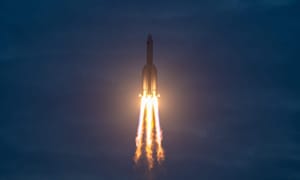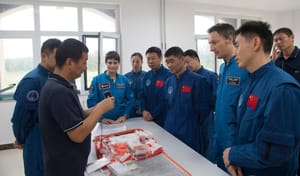
Oct 4, 2023
What makes up China's crewed spaceflight program?
Disclaimer: This article was written on the 17th of September 2023 so some information may be outdated.
This article is intended as a general explanation of the Chinese crewed spaceflight programs and the spacecraft used for them.
Tiangong space station
The Tiangong space station, also called the Chinese space station, is a permanently crewed space station in low Earth orbit operated by the China Manned Space Agency. The space station consists of the Tianhe core module, which was launched first on the 29th of April 2021, the Wentian laboratory module, which was launched second on the 24th of July 2022, and the Mengtian laboratory module, which was launched third on the 31st of October 2022. China currently plans to launch the Xuntian space telescope which will co-orbit with the space station for periodic docking for servicing and maintenance. There are also rumors of a fourth module that would allow up to six spacecraft to dock with the space station. The station currently has a pressurized volume of three hundred and forty cubic meters with one hundred and twenty-two cubic meters of it being habitable.
The Tianhe module functions as the core of the Tiangong space station and provides lift support and living quarters for three crew members. It also provides the guidance, navigation, and orientation control of the space station. Until the Wentian and Mengtian modules were docked it provided all of the space stations power. There is also an airlock to allow the crew to go on spacewalks outside the space station.
The Wentian module functions as a research laboratory in a microgravity, commonly called zero gravity, environment. It also has additional navigation avionics, propulsion, and orientation systems as a backup for the Tianhe module. The module also has a five-meter-long arm to assist with extra-vehicular activities and attach scientific instruments to one of the modules' twenty-two standard adapters on the outside of the module. Wentian also has two large solar arrays, which are one hundred and ten square meters each, to generate power for the space station. There is also another airlock to allow the crew to go on spacewalks outside the space station.
The Mengtian module functions as a microgravity, commonly called zero gravity, laboratory environment. The module also has a pair of experiment cargo doors to allow the experiments to be attached in a pressurized environment and then be moved outside without the need for extra-vehicular activities. Like Wentian, Mengtian has two large solar arrays, which are one hundred and ten square meters each, to generate power for the space station.

Shenzhou spacecraft
The Shenzhou spacecraft is China’s only operational crewed spacecraft and is currently used to ferry its crews to and from the Tiangong space station. The spacecraft has a pressurized volume of almost fifteen cubic meters with a habitable volume of seven cubic meters. Currently, the Shenzhou spacecraft has a crew capacity of three.
Shenzhou consists of a service module, a re-entry module, and an orbital module. During launch and return to Earth the crew are in the re-entry module which is the only part of the spacecraft that survives re-entry into Earth's atmosphere. The service module houses the main engines for the spacecraft as well as the two solar panels to generate power for the spacecraft. The orbital module houses the docking mechanism for the spacecraft and gives the crew additional room inside as well as space for cargo.
The first Shenzhou spacecraft was launched on the 19th of November 1999 uncrewed with the first crewed launch taking place on the 15th of October 2003. Currently, sixteen Shenzhou spacecraft have been launched with no failures so far. All Shenzhou spacecraft launch on the Long March 2F rocket.

Tianzhou spacecraft
The Tianzhou spacecraft is an uncrewed cargo spacecraft developed by China to resupply the Tiangong space station. Tianzhou is derived from China’s first space station, Tiangong-1, and is capable of delivering 7,400 kilograms of cargo to their space station and weighs 14,000 kilograms.
The spacecraft does not possess any way to return cargo back down to Earth and is destroyed on re-entry. So far all Tianzhou spacecraft have been launched on the Long March 7 rocket. There have been six Tianzhou spacecraft launched so far. Tianzhou is also capable of transporting pressurized, semi-pressurized, and un-pressurized cargo. Current versions of the spacecraft are powered by two panels to generate power for the spacecraft.




